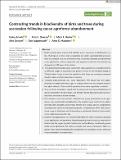Files in this item
Contrasting trends in biodiversity of birds and trees during succession following cacao agroforest abandonment
Item metadata
| dc.contributor.author | Arnold, Haley | |
| dc.contributor.author | Deacon, Amy E. | |
| dc.contributor.author | Hulme, Mark F. | |
| dc.contributor.author | Sansom, Alex | |
| dc.contributor.author | Jaggernauth, Dan | |
| dc.contributor.author | Magurran, Anne E. | |
| dc.date.accessioned | 2021-05-07T15:30:01Z | |
| dc.date.available | 2021-05-07T15:30:01Z | |
| dc.date.issued | 2021-06 | |
| dc.identifier | 273340646 | |
| dc.identifier | b0b9618f-5a5c-433f-aa64-845efafefcc2 | |
| dc.identifier | 85104454051 | |
| dc.identifier | 000646735900001 | |
| dc.identifier.citation | Arnold , H , Deacon , A E , Hulme , M F , Sansom , A , Jaggernauth , D & Magurran , A E 2021 , ' Contrasting trends in biodiversity of birds and trees during succession following cacao agroforest abandonment ' , Journal of Applied Ecology , vol. 58 , no. 6 , pp. 1248-1260 . https://doi.org/10.1111/1365-2664.13869 | en |
| dc.identifier.issn | 0021-8901 | |
| dc.identifier.other | RIS: urn:1FB2A3EC56F67981F64776677A4B2F53 | |
| dc.identifier.other | ORCID: /0000-0002-0036-2795/work/93514568 | |
| dc.identifier.uri | https://hdl.handle.net/10023/23131 | |
| dc.description | This research was supported by the University of St Andrews through the Sir Harold Mitchell bequest. AM also acknowledges support from the Leverhulme Trust (PPG-2019-402). | en |
| dc.description.abstract | 1. Understanding how transformed habitats act as reservoirs of biodiversity is a key challenge at a time when ecosystems are under unprecedented pressure. Here we compare tree and bird biodiversity in actively cultivated and abandoned cacao agroforests, and use a space for time approach to ask how this diversity has changed over 100 years of succession. 2. Tree and bird communities were surveyed in cacao agroforests, secondary forests at different stages of succession and primary forests in the Northern Range of Trinidad, West Indies, to test the prediction that there are consistent temporal trends in alpha and beta‐diversity across taxa. 3. Temporal alpha‐diversity was taxon dependent. We found that tree alpha‐diversity increased with forest age. In contrast, there was no temporal trend in bird alpha‐diversity. Tree and bird species richness were negatively correlated. 4. Tree and bird composition varied with forest age and environmental distance. A greater proportion of native trees, and of highly forest‐dependent and insectivorous birds were found in older forests. 5. Our analyses show that actively cultivated and young abandoned cacao agroforests can sustain high bird alpha‐diversity, despite lower levels of tree alpha‐diversity. Old secondary and primary forests have unique species compositions including more sensitive and specialist species. Compositional shifts with successional stage for both trees and birds produce a patchwork of habitats that contribute to regional gamma‐diversity. 6. Synthesis and applications. Our research highlights the value of actively cultivated cacao agroforests and secondary forest alongside primary forests as reservoirs of biodiversity. By supporting both biodiversity and livelihoods, traditionally grown shade‐cacao agroforests fall within a people and nature framework. Taken together, these results emphasise the contributions of secondary forests, which are often overlooked, to conservation. | |
| dc.format.extent | 13 | |
| dc.format.extent | 1332171 | |
| dc.language.iso | eng | |
| dc.relation.ispartof | Journal of Applied Ecology | en |
| dc.subject | Bird diversity | en |
| dc.subject | Cocoa | en |
| dc.subject | Multi-taxa | en |
| dc.subject | People and nature | en |
| dc.subject | Secondary forest succession | en |
| dc.subject | Tree diversity | en |
| dc.subject | Tropical forest biodiversity conservation | en |
| dc.subject | QH301 Biology | en |
| dc.subject | DAS | en |
| dc.subject.lcc | QH301 | en |
| dc.title | Contrasting trends in biodiversity of birds and trees during succession following cacao agroforest abandonment | en |
| dc.type | Journal article | en |
| dc.contributor.sponsor | The Leverhulme Trust | en |
| dc.contributor.institution | University of St Andrews. School of Biology | en |
| dc.contributor.institution | University of St Andrews. Centre for Biological Diversity | en |
| dc.contributor.institution | University of St Andrews. Scottish Oceans Institute | en |
| dc.contributor.institution | University of St Andrews. Institute of Behavioural and Neural Sciences | en |
| dc.contributor.institution | University of St Andrews. St Andrews Sustainability Institute | en |
| dc.contributor.institution | University of St Andrews. Centre for Research into Ecological & Environmental Modelling | en |
| dc.contributor.institution | University of St Andrews. Fish Behaviour and Biodiversity Research Group | en |
| dc.contributor.institution | University of St Andrews. Marine Alliance for Science & Technology Scotland | en |
| dc.identifier.doi | 10.1111/1365-2664.13869 | |
| dc.description.status | Peer reviewed | en |
| dc.identifier.grantnumber | ORPG-8061 | en |
This item appears in the following Collection(s)
Items in the St Andrews Research Repository are protected by copyright, with all rights reserved, unless otherwise indicated.

